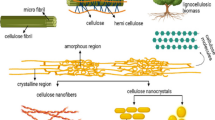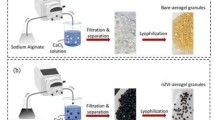Abstract
Magnetite-coated pine cone biomass was successfully synthesized, characterized, and its interaction with As (III) in water evaluated in order to apply it as an efficient adsorbent. Transmission electron microscope, scanning electron microscope, and imaging studies revealed that spherical magnetite particles were evenly distributed over the pine cone surface. Adsorption studies showed that the optimum pH of As (III) adsorption was 8 and that Fe (III) leaching was negligible at this pH. The optimum Fe3O4:pine cone ratio for As (III) removal was 2.0 g Fe3O4:1.5 g pine cone with adsorption capacity of 13.86 mg/g. The pseudo-second-order model best fitted the kinetic data with activation energy of adsorption was calculated to be 23.78 kJ/mol. The Langmuir isotherm described the equilibrium data best while the values of Dubinin–Radushkevich mean free energy suggests anion-exchange process. Increasing ionic strength slightly increased As (III) capacity of MNP-PCP from 13.86 to 17.82 mg/g at optimum solution pH of 8, but As (III) adsorption reduced by \( {\mathrm{PO}}_4^{3-} \)anions and humic acid due to competition. Adsorption mechanism was confirmed with evidence from FTIR, XPS, pHPZC, and \( {\mathrm{NO}}_3^{-} \) replacement by As (III) adsorption onto the \( {\mathrm{NO}}_3^{-} \)-loaded composite.










Similar content being viewed by others
References
Aaron DR, Macalady DL, Ahmann D (2002) Natural Organic Matter Affects Arsenic Speciation and Sorption onto Hematite. Environ Sci Technol 36:2889–2896
Amin MN, Kaneco S, Kitagawa T, Begum A, Katsumata H, Suzuki T, Ohta K (2006) Removal of arsenic in aqueous solutions by adsorption onto waste rice husk. Ind Eng Chem Res 45:8105–8110
Ansone L, Klavins M, Viksna A (2013) Arsenic removal using natural biomaterial-based sorbents. Environ Geochem Health 35:633–642
Aryal M, Ziagova M, Liakopoulou-Kyriakides M (2010) Study on arsenic biosorption using Fe (III)-treated biomass of Staphylococcus xylosus. Chem Eng J 162:178–185
Banerjee S, Chattopadhyaya M (2017) Adsorption characteristics for the removal of a toxic dye, tartrazine from aqueous solutions by a low cost agricultural by-product. Arab J Chem 10:S1629–S1638
Biswas BK, Inoue J-i, Inoue K, Ghimire KN, Harada H, Ohto K, Kawakita H (2008) Adsorptive removal of As (V) and As (III) from water by a Zr (IV)-loaded orange waste gel. J Hazard Mater 154:1066–1074
Burton ED, Bush RT, Johnston SG, Watling KM, Hocking RK, Sullivan LA, Parker GK (2009) Sorption of arsenic (V) and arsenic (III) to schwertmannite. Environ. Sci. Technol. 43:9202–9207
Chang F, Qu J, Liu H, Liu R, Zhao X (2009) Fe–Mn binary oxide incorporated into diatomite as an adsorbent for arsenite removal: preparation and evaluation. J Colloid Interface Sci 338:353–358
Chung J-Y, Yu S-D, Hong Y-S (2014) Environmental source of arsenic exposure. J Prev Medi Public Health 47:253–257
Cumbal L, SenGupta AK (2005) Arsenic removal using polymer-supported hydrated iron (III) oxide nanoparticles: role of Donnan membrane effect. Environ Sci Technol 39:6508–6515
Fang L, Ghimire KN, Kuriyama M, Inoue K, Makino K (2003) Removal of fluoride using some lanthanum (III)-loaded adsorbents with different functional groups and polymer matrices. J Chem Technol Biotechnol 78:1038–1047
Giasuddin ABM, Kanel SR, Choi H (2007) Adsorption of Humic Acid onto Nanoscale Zerovalent Iron and Its Effect on Arsenic Removal. Environ Sci Technol 41:2022–2027
Goldberg S, Johnston CT (2001) Mechanisms of arsenic adsorption on amorphous oxides evaluated using macroscopic measurements, vibrational spectroscopy, and surface complexation modeling. J Colloid Interface Sci 234:204–216
Goldberg S (2002) Competitive adsorption of arsenate and arsenite on oxides and clay minerals. Soil Sci Soc Am J 66:413–421
Goswami A, Raul P, Purkait M (2012) Arsenic adsorption using copper (II) oxide nanoparticles. Chem Eng Res Des 90:1387–1396
Gupta V, Nayak A (2012a) Cadmium removal and recovery from aqueous solutions by novel adsorbents prepared from orange peel and Fe2O3 nanoparticles. Chem Eng J 180:81–90
Gupta V, Nayak A (2012b) Cadmium removal and recovery from aqueous solutions by novel adsorbents prepared from orange peel and Fe2O3 nanoparticles. Chem Eng J 180:81–90
Hao L, Ouyang T, Lai L, Liu Y-X, Chen S, Hu H, Chang C-T, Wang J-J (2014) Temperature effects on arsenate adsorption onto goethite and its preliminary application to arsenate removal from simulative geothermal water. RSC Adv 4:51984–51990
Hua M, Yang B, Shan C, Zhang W, He S, Lv L, Pan B (2017) Simultaneous removal of As (V) and Cr (VI) from water by macroporous anion exchanger supported nanoscale hydrous ferric oxide composite. Chemosphere 171:126–133
Kamala C, Chu K, Chary N, Pandey P, Ramesh S, Sastry A, Sekhar KC (2005) Removal of arsenic (III) from aqueous solutions using fresh and immobilized plant biomass. Water Res 39:2815–2826
Kanel SR, Greneche JM, Choi H (2006) Removal of arsenic (III) from groudwater using nano scale zero-valent iron. Environ Sci Technol 39:1291–1298
Karthick K, Namasivayam C, Pragasan LA (2017) Removal of direct red 12B from aqueous medium by ZnCl2 activated Jatropha husk carbon: adsorption dynamics and equilibrium studies. Indian J Chem Technol 24:73–81
Kumar E, Bhatnagar A, Hogland W, Marques M, Sillanpää M (2014) Interaction of inorganic anions with iron-mineral adsorbents in aqueous media—a review. Adv Colloid Interf Sci 203:11–21
Lakshmipathiraj P, Narasimhan B, Prabhakar S, Raju GB (2006) Adsorption studies of arsenic on Mn-substituted iron oxyhydroxide. J Colloid Interface Sci 304:317–322
Lien H-L, Zhang W-X (2007) Nanoscale Pd/Fe bimetallic particles: catalytic effects of palladium on hydrodechlorination. Appl Catal B Environ 77:110–116
Liu J-F, Zhao Z-S, Jiang G-B (2008) Coating Fe3 O4 Magnetic Nanoparticles with Humic Acid for High Efficient Removal of Heavy Metals in Water. Environ Sci Technol 42:6949–6954
Lunge S, Singh S, Sinha A (2014) Magnetic iron oxide (Fe3O4) nanoparticles from tea waste for arsenic removal. J Magn Magn Mater 356:21–31
Mahanta N, Chen JP (2013) A novel route to the engineering of zirconium immobilized nano-scale carbon for arsenate removal from water. J Mater Chem A 1:8636–8644
Meng F, Yang B, Wang B, Duan S, Chen Z, Ma W (2017) Novel Dendrimerlike magnetic biosorbent based on modified orange peel waste: adsorption–reduction behavior of arsenic. ACS Sustain Chem Eng 5:9692–9700
Meng X, Korfiatis G, Jing C, Christodoulatos C (2001) Redox transformations of arsenic and Iron in water treatment, sludge during aging and TCLP extraction. Environ Sci Technol 35:3476–3481
Mittal A, Kurup L, Mittal J (2007) Freundlich and Langmuir adsorption isotherms and kinetics for the removal of Tartrazine from aqueous solutions using hen feathers. J Hazard Mater 146:243–248
Nashine A, Tembhurkar A (2016) Equilibrium, kinetic and thermodynamic studies for adsorption of As (III) on coconut (Cocos nucifera L.) fiber. J Environ Chem Eng 4:3267–3273
Ofomaja AE, Naidoo EB, Modise SJ (2009) Removal of copper (II) from aqueous solution by pine and base modified pine cone powder as biosorbent. J Hazard Mater 168:909–917
Pena M, Meng X, Korfiatis GP, Jing C (2006) Adsorption mechanism of arsenic on nanocrystalline titanium dioxide. Environ Sci Technol 40:1257–1262
Peter KT, Johns AJ, Myung NV, Cwiertny DM (2017) Functionalized polymer-iron oxide hybrid nanofibers: electrospun filtration devices for metal oxyanion removal. Water Res 117:207–217
Ranjan D, Talat M, Hasan S (2009) Biosorption of arsenic from aqueous solution using agricultural residue ‘rice polish’. J Hazard Mater 166:1050–1059
Renkou X, Yong W, Tiwari D, Houyan W (2009) Effect of ionic strength on adsorption of As (III) and As (V) on variable charge soils. J Environ Sci 21:927–932
Reza RA, Ahmaruzzaman M (2015) A novel synthesis of Fe 2 O 3@ activated carbon composite and its exploitation for the elimination of carcinogenic textile dye from an aqueous phase. RSC Adv 5:10575–10586
Sahu UK, Sahu S, Mahapatra SS, Patel RK (2017) Cigarette soot activated carbon modified with Fe3O4 nanoparticles as an effective adsorbent for As (III) and As (V): material preparation, characterization and adsorption mechanism study. J Mol Liq 243:395–405
Santra D, Sarkar M (2016) Optimization of process variables and mechanism of arsenic (V) adsorption onto cellulose nanocomposite. J Mol. Liq 224:290–302
Setyono D, Valiyaveettil S (2014) Chemically modified sawdust as renewable adsorbent for arsenic removal from water. ACS Sustain Chem Eng 2:2722–2729
Subramanian K, Kumar PS, Jeyapal P, Venkatesh N (2005) Characterization of ligno-cellulosic seed fibre from Wrightia Tinctoria plant for textile applications—an exploratory investigation. Eur Polym J 41:853–861
Tian Y, Wu M, Lin X, Huang P, Huang Y (2011) Synthesis of magnetic wheat straw for arsenic adsorption. J Hazard Mater 193:10–16
Van Vinh N, Zafar M, Behera S, Park H-S (2015) Arsenic (III) removal from aqueous solution by raw and zinc-loaded pine cone biochar: equilibrium, kinetics, and thermodynamics studies. Int J Environ Sci Technol 12:1283–1294
Venkatesan G, Narayanan SL (2018) Synthesis of Fe2O3-coated and HCl-treated bauxite ore waste for the adsorption of arsenic (III) from aqueous solution: isotherm and kinetic models. Chem Eng Commun 205:34–46
Weber WJ, Morris JC (1963) Kinetics of adsorption on carbon from solution. J Sanit Eng Div 89:31–60
Wilson D, Langell M (2014) XPS analysis of oleylamine/oleic acid capped Fe3O4 nanoparticles as a function of temperature. Appl Surf Sci 303:6–13
Wu K, Liu R, Li T, Liu H, Peng J, Qu J (2013) Removal of arsenic (III) from aqueous solution using a low-cost by-product in Fe-removal plants—Fe-based backwashing sludge. Chem Eng J 226:393–401
Yoon Y, Zheng M, Ahn Y-T, Park WK, Yang WS, Kang J-W (2017) Synthesis of magnetite/non-oxidative graphene composites and their application for arsenic removal. Sep Purif Technol 178:40–48
Yoshida I (1981) Adsorption of arsenic (III) ion on various ion exchange resins loaded with iron (III) and zirconium (IV). Bull Chem Soc Jpn 3:379–384
Yu F, Sun S, Ma J, Han S (2015) Enhanced removal performance of arsenate and arsenite by magnetic graphene oxide with high iron oxide loading. Phys Chem Chem Phys 17:4388–4397
Yu X, Tong S, Ge M, Zuo J, Cao C, Song W (2013) One-step synthesis of magnetic composites of cellulose@ iron oxide nanoparticles for arsenic removal. J Mater Chem A 1:959–965
Zhang S, Li X-y, Chen JP (2010) An XPS study for mechanisms of arsenate adsorption onto a magnetite-doped activated carbon fiber. J Colloid Interface Sci 343:232–238
Zhang W, Zheng J, Zheng P, Tsang DC, Qiu R (2015) Sludge-derived biochar for arsenic (III) immobilization: effects of solution chemistry on sorption behavior. J Environ Qual 44:1119–1126
Zhao Z, Jia Y, Xu L, Zhao S (2011) Adsorption and heterogeneous oxidation of As (III) on ferrihydrite. Water Res 45:6496–6504
Zhou S, Wang D, Sun H, Chen J, Wu S, Na P (2014) Synthesis, characterization, and adsorptive properties of magnetic cellulose nanocomposites for arsenic removal. Water Air Soil Pollut 225:1945
Author information
Authors and Affiliations
Corresponding author
Additional information
Responsible editor: Tito Roberto Cadaval Jr
Electronic supplementary material
ESM 1
(DOCX 37.8 kb)
Rights and permissions
About this article
Cite this article
Pholosi, A., Naidoo, B.E. & Ofomaja, A.E. Clean application of magnetic biomaterial for the removal of As (III) from water. Environ Sci Pollut Res 25, 30348–30365 (2018). https://doi.org/10.1007/s11356-018-2990-2
Received:
Accepted:
Published:
Issue Date:
DOI: https://doi.org/10.1007/s11356-018-2990-2




